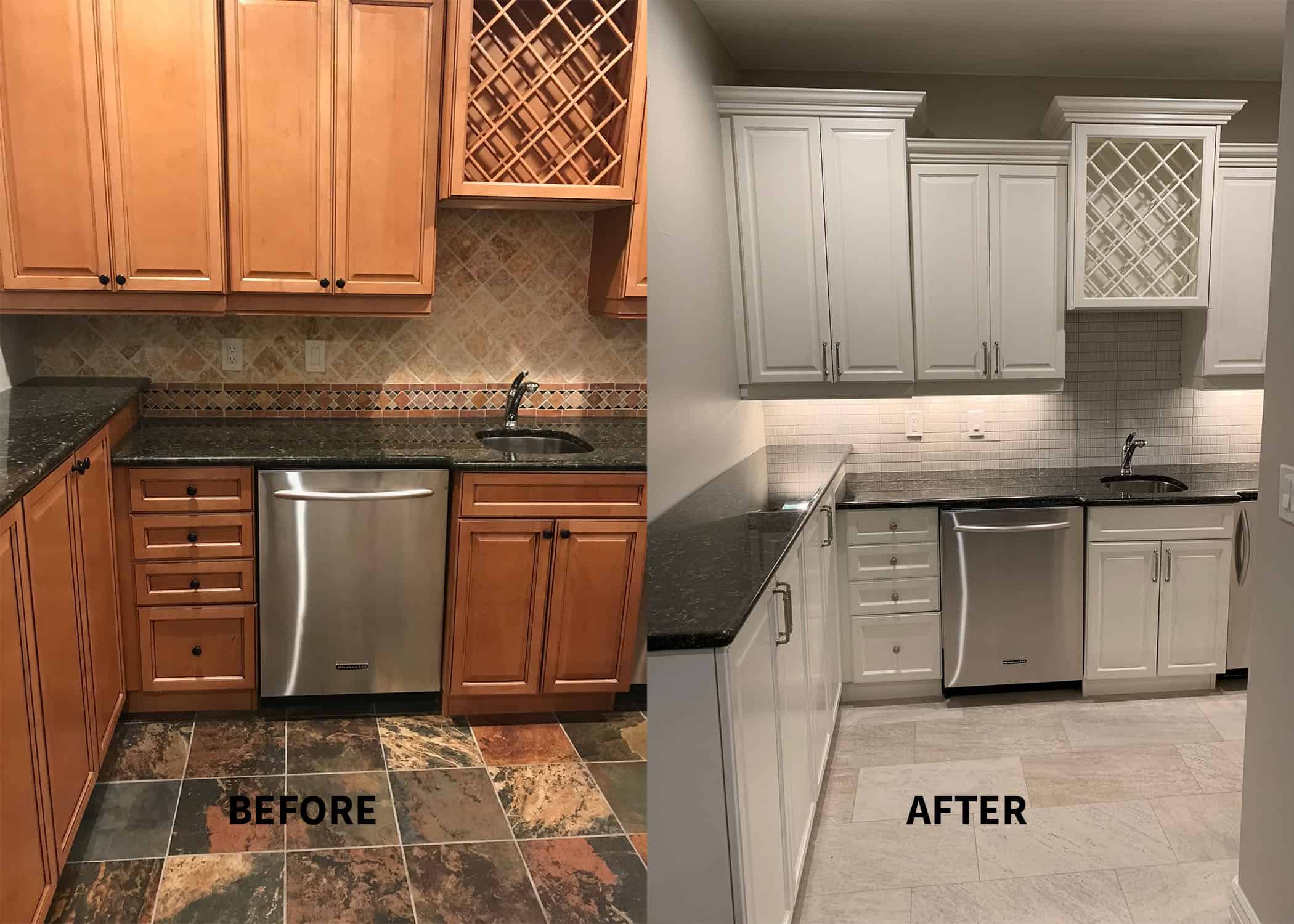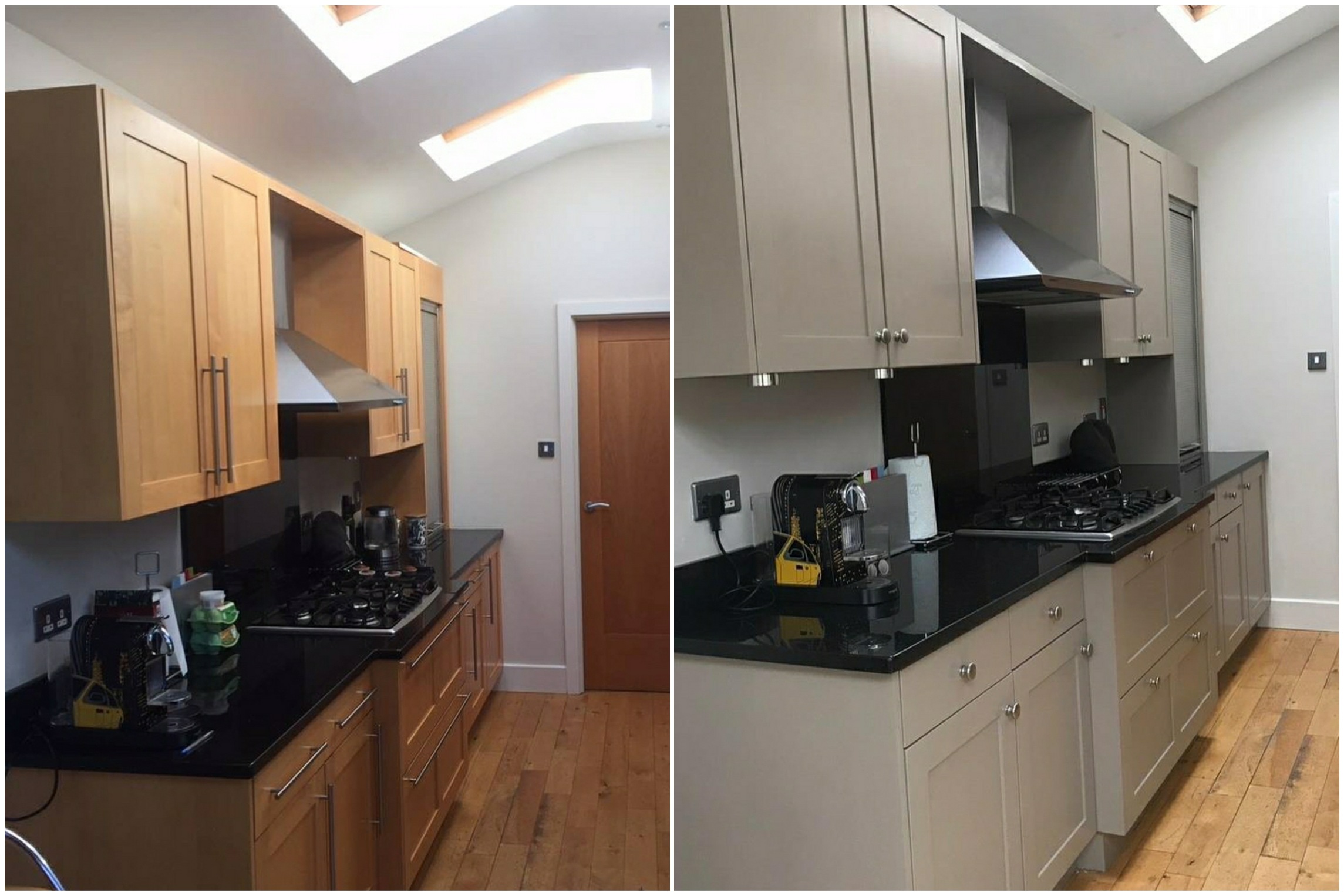Pre-Painting Preparation: Painting Laminate Cabinets Before And After

A whispered sigh escapes the old cabinets, their laminate surfaces dulled by time and use. The transformation begins, a slow, deliberate unveiling of their hidden potential. Preparation, a somber ritual, is key to a lasting, beautiful result. Each step, a careful brushstroke on the canvas of their aging wood.
Painting laminate cabinets before and after – Cleaning the laminate is the first act in this quiet drama. It’s a delicate dance between removing grime and avoiding damage. The right approach ensures a clean slate for the paint’s embrace. The wrong approach can lead to a finish that fades as quickly as a forgotten memory.
Cleaning Methods for Laminate Cabinets
Choosing the appropriate cleaning method is crucial for preparing the surface. Too harsh a cleaner can damage the laminate, while an inadequate one leaves behind residue that compromises the paint’s adhesion. The following table compares different cleaning methods, highlighting their effectiveness and potential drawbacks.
| Cleaning Method | Effectiveness | Pros | Cons |
|---|---|---|---|
| Warm soapy water | Good for light grime | Gentle, readily available | Ineffective against stubborn grease or stains |
| Degreaser (e.g., TSP substitute) | Excellent for grease and grime | Removes stubborn stains effectively | Can be harsh, requires thorough rinsing |
| Isopropyl alcohol (70%) | Good for removing sticky residue | Effective, evaporates quickly | Can damage some laminate surfaces; test in an inconspicuous area first. |
| Baking soda paste | Good for light scrubbing | Gentle abrasive, environmentally friendly | Can be time-consuming |
Sanding Laminate Cabinets
Sanding, a necessary evil, creates a surface texture that helps the paint adhere. It’s a delicate balance; too much sanding damages the laminate, too little leaves the paint vulnerable. The goal is to gently scuff the surface, creating microscopic grooves for better bonding, not to remove the laminate itself.
- Begin with a high-grit sandpaper (220-grit or higher) to avoid scratches.
- Use a sanding block for even pressure and avoid gouges.
- Sand in the direction of the wood grain (if visible).
- Wipe the surface clean with a tack cloth after sanding to remove dust.
- Repeat the process with progressively finer grit sandpaper if needed, for a smoother finish.
Primer Selection for Laminate Cabinets
Priming is the silent guardian, bridging the gap between the laminate and the paint. The right primer ensures a strong bond and prevents the paint from peeling or chipping. A poor choice leads to disappointment and the echoes of wasted effort.
| Primer Type | Benefits | Drawbacks |
|---|---|---|
| Adhesion promoter | Excellent bonding to slick surfaces | May require additional coats of primer |
| Oil-based primer | Good stain blocking, durable | Strong odor, longer drying time |
| Sheen-adjusting primer | Provides a uniform base for paint | May not be suitable for all laminate types |
Filling Gaps and Imperfections
Before the final act, imperfections must be addressed. The gentle application of filler is a meditative process, smoothing away flaws and preparing the surface for the paint’s embrace. It’s a testament to the transformative power of careful attention to detail. Use a high-quality wood filler, applying it sparingly with a putty knife. Allow it to dry completely before sanding smooth. The goal is a seamless transition, erasing the passage of time.
Painting Techniques and Paint Selection

The chipped laminate, a pale ghost of its former self, whispers tales of forgotten meals and hurried mornings. Each brushstroke will be a eulogy, a covering of faded memories. The transformation, a bittersweet symphony of paint and regret.
Choosing the right paint and applying it skillfully is crucial for a durable and aesthetically pleasing finish. The wrong choice can lead to peeling, cracking, and a final result that feels as brittle as a forgotten promise.
Paint Type Comparison
Several paint types offer varying degrees of success on laminate surfaces. The selection depends on desired durability, finish, and the level of preparation already undertaken. A careful consideration of these factors will determine the longevity and aesthetic appeal of the final product.
| Paint Type | Durability | Finish | Application Method |
|---|---|---|---|
| Oil-based Alkyd Enamel | High; resistant to scratches and moisture | High-gloss, semi-gloss, satin | Brush, roller, spray |
| Acrylic-Latex Enamel | Moderate; durable but less resistant to moisture than alkyd | High-gloss, semi-gloss, satin, eggshell | Brush, roller, spray |
| Specialty Laminate Paints | High; specifically formulated for adhesion to laminate | Various finishes available | Brush, roller, spray |
| Chalk Paint | Low; requires a sealant for durability | Matte, chalky finish | Brush |
Applying Paint to Laminate Cabinets
The act of painting is a meditation; each stroke a prayer for a flawless finish. Precision and patience are paramount, transforming the mundane into something beautiful.
- Apply a high-quality primer specifically designed for laminate surfaces. This ensures proper adhesion and prevents the paint from peeling.
- Use a high-quality brush or roller with a nap suitable for the type of paint chosen. Avoid cheap tools, as they can leave streaks and imperfections.
- Apply thin, even coats, allowing each coat to dry completely before applying the next. Avoid overloading the brush or roller to prevent drips and runs.
- Use smooth, consistent strokes in one direction, then lightly smooth over in the opposite direction to minimize brushstrokes. The goal is an even, seamless finish.
- Sand lightly between coats with fine-grit sandpaper to create a smoother surface and improve adhesion.
Multiple Coats and Drying Time
Each coat unveils a new layer of transformation, a gradual unveiling of the finished product. The patience required mirrors the slow unfolding of a cherished memory.
Applying multiple coats is essential for achieving a durable and even finish. The first coat will often appear patchy and uneven, revealing the underlying laminate. The second coat will even out the surface and increase coverage. Subsequent coats will build depth and richness, creating a smoother, more uniform surface. Drying time between coats varies depending on the type of paint and environmental conditions, typically ranging from 2-4 hours.
Painting Cabinet Doors and Drawers
The delicate dance of removing hardware, painting each piece individually, and then meticulously reassembling is a testament to the dedication required for true transformation. Each piece is a memory, carefully handled and restored.
- Remove all cabinet doors and drawers. Carefully remove hinges and knobs, labeling each piece to ensure proper reinstallation.
- Clean all surfaces thoroughly with a degreaser to remove any grease or grime.
- Apply primer to all surfaces, following the manufacturer’s instructions.
- Apply paint in thin, even coats, allowing each coat to dry completely before applying the next.
- Once the paint is dry, carefully reattach the hinges and knobs, ensuring proper alignment.
- Reinstall the doors and drawers, admiring the renewed beauty.
Post-Painting Care and Maintenance

The transformation is complete. Your laminate cabinets, once dull and lifeless, now gleam with fresh paint, a testament to your hard work. But this newfound beauty is fragile, a fleeting moment captured in time, unless you take the necessary steps to preserve it. The coming months and years will test the resilience of your handiwork; a gentle touch is now required where once a careless hand sufficed.
Protecting your newly painted cabinets requires a mindful approach, a delicate dance between practicality and preservation. The initial weeks are critical; a period of careful tending, where even the smallest mishap can undo hours of labor. The longer-term care is equally important, ensuring your cabinets remain a source of pride and joy for years to come, a silent witness to the passage of time.
Protecting Painted Laminate Cabinets from Scratches and Damage
Preventing damage is far easier than repairing it. A proactive approach, focused on minimizing potential hazards, is the key to preserving your painted finish. The following preventative measures will significantly extend the life of your newly painted cabinets.
- Install protective bumpers on cabinet doors and drawers to prevent scratches from impacts.
- Use soft cloths or microfiber towels when cleaning to avoid abrasive scratching.
- Handle heavy items carefully, avoiding abrupt movements or forceful impacts.
- Keep sharp objects away from the cabinet surfaces. Consider using drawer liners to protect the interiors.
- Be mindful of pets and children; their playful energy can easily inflict damage.
Proper Cleaning Methods for Maintaining the Painted Finish
For regular cleaning, use a soft, damp cloth and a mild dish soap solution. Avoid harsh chemicals, abrasive cleaners, and scouring pads, as these can damage the painted surface. Rinse thoroughly with clean water and dry completely with a soft cloth to prevent water spots. For stubborn stains, a very gentle application of a non-abrasive all-purpose cleaner can be used, but always test it on an inconspicuous area first. Remember, gentleness is key; treat your cabinets with the same care you would a cherished heirloom.
Common Problems and Solutions When Painting Laminate Cabinets, Painting laminate cabinets before and after
Despite careful preparation and application, challenges can arise. Understanding these common problems and their solutions will help you address any issues that may occur and maintain the integrity of your painted finish.
| Problem | Solution |
|---|---|
| Peeling or chipping paint | Ensure proper surface preparation before painting, including thorough cleaning and priming. Use high-quality paint designed for laminate surfaces. Address any underlying issues, such as moisture damage, before repainting. |
| Uneven paint application | Use thin, even coats of paint, allowing each coat to dry completely before applying the next. Use a high-quality brush or roller for a smooth finish. Consider using a paint sprayer for a more even application, especially on large surfaces. |
| Yellowing or discoloration | Use a high-quality paint specifically formulated to resist yellowing. Ensure proper ventilation during painting and drying to prevent moisture buildup. Avoid exposing the cabinets to direct sunlight, which can accelerate discoloration. |
| Scratches or scuff marks | Use protective measures to minimize scratches. For minor scratches, use a touch-up paint pen to blend the imperfections. For deeper scratches, you may need to sand and repaint the affected area. |
